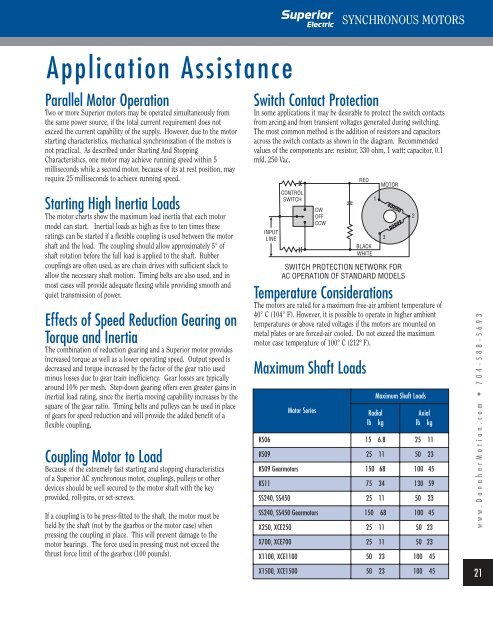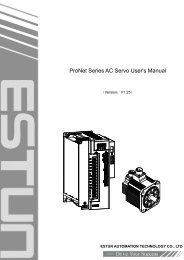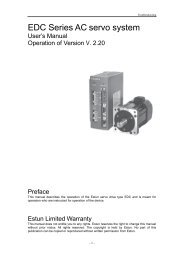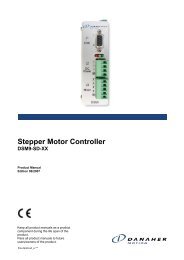Create successful ePaper yourself
Turn your PDF publications into a flip-book with our unique Google optimized e-Paper software.
<strong>SYNCHRONOUS</strong> <strong>MOTORS</strong><br />
Application Assistance<br />
Parallel Motor Operation<br />
Two or more Superior motors may be operated simultaneously from<br />
the same power source, if the total current requirement does not<br />
exceed the current capability of the supply. However, due to the motor<br />
starting characteristics, mechanical synchronization of the motors is<br />
not practical. As described under Starting And Stopping<br />
Characteristics, one motor may achieve running speed within 5<br />
milliseconds while a second motor, because of its at rest position, may<br />
require 25 milliseconds to achieve running speed.<br />
Starting High Inertia Loads<br />
The motor charts show the maximum load inertia that each motor<br />
model can start. Inertial loads as high as five to ten times these<br />
ratings can be started if a flexible coupling is used between the motor<br />
shaft and the load. The coupling should allow approximately 5° of<br />
shaft rotation before the full load is applied to the shaft. Rubber<br />
couplings are often used, as are chain drives with sufficient slack to<br />
allow the necessary shaft motion. Timing belts are also used, and in<br />
most cases will provide adequate flexing while providing smooth and<br />
quiet transmission of power.<br />
Effects of Speed Reduction Gearing on<br />
Torque and Inertia<br />
The combination of reduction gearing and a Superior motor provides<br />
increased torque as well as a lower operating speed. Output speed is<br />
decreased and torque increased by the factor of the gear ratio used<br />
minus losses due to gear train inefficiency. Gear losses are typically<br />
around 10% per mesh. Step-down gearing offers even greater gains in<br />
inertial load rating, since the inertia moving capability increases by the<br />
square of the gear ratio. Timing belts and pulleys can be used in place<br />
of gears for speed reduction and will provide the added benefit of a<br />
flexible coupling.<br />
Coupling Motor to Load<br />
Because of the extremely fast starting and stopping characteristics<br />
of a Superior AC synchronous motor, couplings, pulleys or other<br />
devices should be well secured to the motor shaft with the key<br />
provided, roll-pins, or set-screws.<br />
If a coupling is to be press-fitted to the shaft, the motor must be<br />
held by the shaft (not by the gearbox or the motor case) when<br />
pressing the coupling in place. This will prevent damage to the<br />
motor bearings. The force used in pressing must not exceed the<br />
thrust force limit of the gearbox (100 pounds).<br />
Switch Contact Protection<br />
In some applications it may be desirable to protect the switch contacts<br />
from arcing and from transient voltages generated during switching.<br />
The most common method is the addition of resistors and capacitors<br />
across the switch contacts as shown in the diagram. Recommended<br />
values of the components are: resistor, 330 ohm, 1 watt; capacitor, 0.1<br />
mfd, 250 Vac.<br />
INPUT<br />
LINE<br />
CONTROL<br />
SWITCH<br />
CW<br />
OFF<br />
CCW<br />
RED<br />
BLACK<br />
WHITE<br />
1<br />
MOTOR<br />
SWITCH PROTECTION NETWORK FOR<br />
AC OPERATION OF STANDARD MODELS<br />
Temperature Considerations<br />
The motors are rated for a maximum free-air ambient temperature of<br />
40° C (104° F). However, it is possible to operate in higher ambient<br />
temperatures or above rated voltages if the motors are mounted on<br />
metal plates or are forced-air cooled. Do not exceed the maximum<br />
motor case temperature of 100° C (212º F).<br />
Maximum Shaft Loads<br />
Motor Series<br />
3<br />
Radial<br />
lb kg<br />
2<br />
Maximum Shaft Loads<br />
Axial<br />
lb kg<br />
KS06 15 6.8 25 11<br />
KS09 25 11 50 23<br />
KS09 Gearmotors 150 68 100 45<br />
KS11 75 34 130 59<br />
SS240, SS450 25 11 50 23<br />
SS240, SS450 Gearmotors 150 68 100 45<br />
X250, XCE250 25 11 50 23<br />
X700, XCE700 25 11 50 23<br />
X1100, XCE1100 50 23 100 45<br />
X1500, XCE1500 50 23 100 45<br />
www.DanaherMotion.com • 704-588-5693<br />
21





